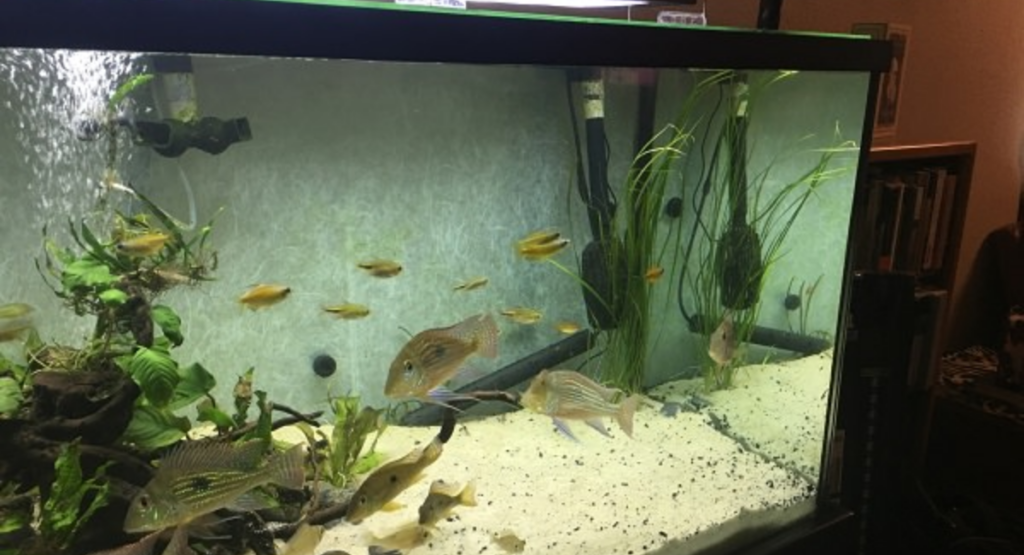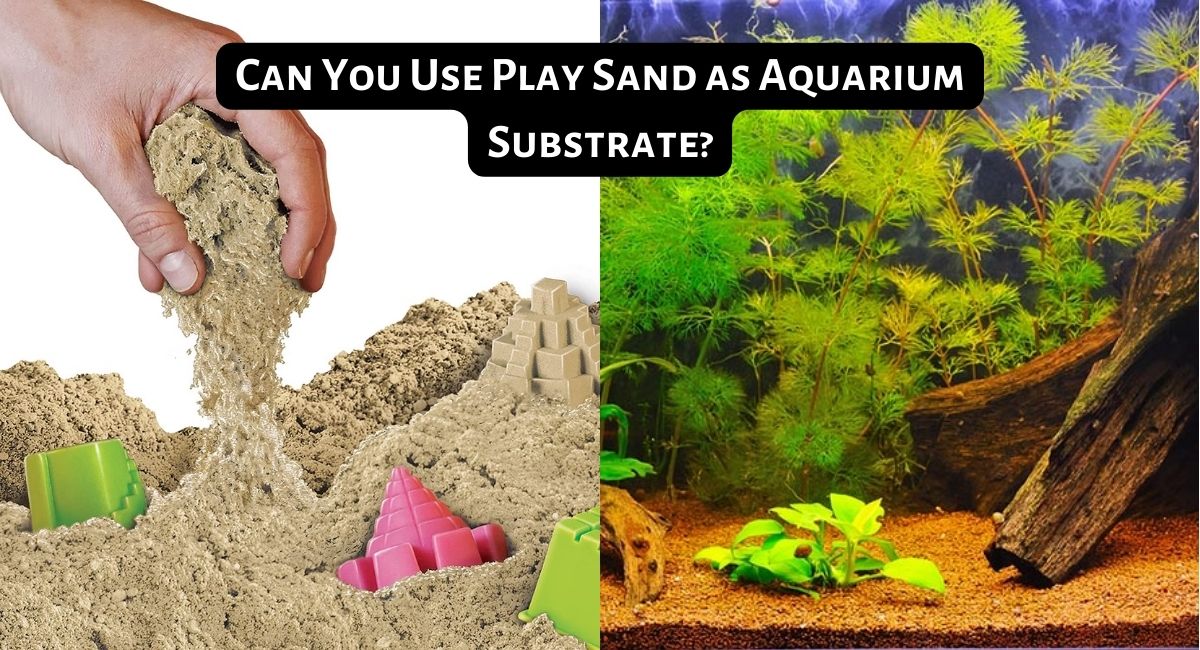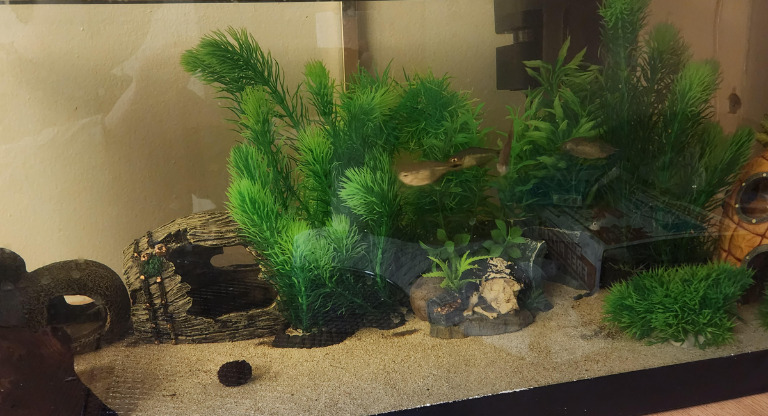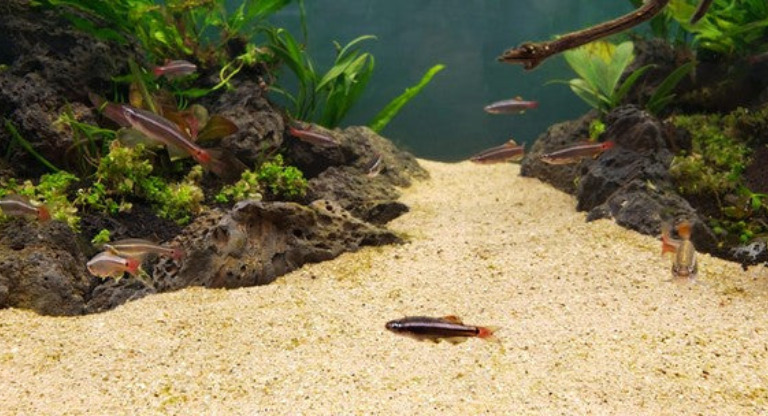Smartplantedaquarium.com participates in affiliate marketing programs. We may earn commissions on purchases made through our affiliate links. This doesn't affect our content or recommendations and we only recommend products we would put in our own tanks.
Ever wondered if you could use that bag of play sand for more than just your kid’s sandbox? As an aquarium hobbyist, you may be tempted by play sand’s low cost and easy availability. But before pouring it into your fish tank, there are some important considerations.
In this quick guide, we’ll cover the pros and cons of play sand as an aquarium substrate. You’ll learn how particle size, composition, and quality control could impact your aquatic residents.
With the right precautions, play sand can be a budget-friendly substrate option, but it doesn’t come without risks.
Read on to discover if play sand will sink or swim in your aquarium. Making an informed choice now will save you headaches down the road.
Contents
- Key Takeaways
- Is Play Sand Safe as Aquarium Substrate
- Is There a Difference Between Play Sand and Aquarium Sand
- When Play Sand is a Good Choice
- When Play Sand Isn’t the Best Choice for Aquarium
- How to Prepare Play Sand for Your Aquarium
- Maintain Play Sand in Your Aquarium
- Conclusion
- Frequently Asked Questions
- 1. Can play sand affect the water chemistry in the aquarium?
- 2. How deep should the play sand substrate be in an aquarium?
- 3. Can play sand be mixed with other types of substrates in an aquarium?
- 4. How often should play sand substrate be cleaned or replaced in an aquarium?
- 5. Can aquarium plants grow in play sand?
Key Takeaways
- Play sand can be used as aquarium substrate, but it has both advantages and disadvantages.
- Advantages of play sand include its affordability, natural aesthetics, soft texture, ease of maintenance, and compatibility with certain fish species and invertebrates.
- However, there are also potential disadvantages such as compaction and anaerobic zones, nutrient deficiency for plants, pH and water parameter challenges, particle size and cloudiness, potential for uneven substrate, maintenance and stirring requirements, limited beneficial bacteria colonization, potential pH swings, and lack of aesthetic variation.
- There are notable differences between play sand and aquarium sand, with aquarium sand being better suited for aquatic environments and offering better water quality, safety, and support for fish, plants, and other inhabitants.
- Play sand is a good choice for budget-conscious setups, non-planted tanks, burrowing species, creative aquascaping, DIY projects, and temporary tanks.
- Play sand isn’t the best choice for planted tanks, high-maintenance setups, sensitive fish species, certain aquatic invertebrates, and complex aquascaping projects.
- To prepare play sand for the aquarium, measure the amount needed, mix it with water and let it settle, clean the sand by stirring and pouring off cloudy water, and rinse it under running water.
- It’s important to make an informed decision about using play sand as aquarium substrate to ensure a safe and healthy environment for your fish.
Is Play Sand Safe as Aquarium Substrate
Yes, it is safe to use play sand as aquarium substrate. Play sand is a cheaper and more affordable option, especially for beginners. It can add color and visual appeal to the tank. But before you decide to use play sand in your aquarium, let’s go over its advantages and disadvantages.

Advantages
While it might not be the most conventional choice, play sand can offer some noteworthy benefits for your aquatic environment. Here are the key advantages of using play sand as an aquarium substrate:
1. Cost-Effective Choice: One of the primary benefits of play sand is its affordability. It is significantly cheaper compared to specialized aquarium substrates, making it an attractive option for aquarium enthusiasts on a budget.
2. Natural Aesthetics: Play sand mimics the appearance of natural aquatic environments. Its fine texture and soft color create a visually appealing and authentic underwater landscape, enhancing the overall aesthetics of your aquarium.
3. Soft and Comfortable: The soft texture of play sand provides a comfortable substrate for fish that prefer to burrow, sift, or graze along the bottom of the tank. This can promote natural behaviors and contribute to the well-being of certain species.
4. Ease of Maintenance: Play sand is relatively easy to clean and maintain. Solid waste tends to stay on the surface, making it simpler to remove during regular tank cleaning. This feature can save time and effort compared to substrates that trap debris.
5. Versatility: Play sand can be used in various types of aquarium setups, from freshwater to brackish environments. Its neutral appearance and compatibility with a wide range of aquatic species make it a versatile choice for different tank setups.
6. Compatibility with Certain Fish Species: Bottom-dwelling fish, such as catfish and loaches, benefit from the softness of play sand. These fish often engage in activities like burrowing or sifting through the substrate, and the play sand accommodates these behaviors well.
7. Suitable for Non-Planted Tanks: If you’re maintaining an aquarium without live plants, play sand can be an excellent option. Since plants aren’t present, the lack of nutrients in play sand becomes less of a concern.
8. Creative Aquascaping Possibilities: Play sand allows for creativity in aquascaping. You can create sand dunes, slopes, and patterns that add dimension to your tank’s design.
9. Compatibility with Certain Invertebrates: Some invertebrates, like certain types of shrimp, also enjoy sifting through sand. Play sand can provide them with a suitable substrate to carry out their natural behaviors.
Disadvantages
While play sand has its advantages as an aquarium substrate, it’s essential to consider its potential disadvantages before making a decision. Here are some drawbacks associated with using play sand in your aquarium:
1. Compaction and Anaerobic Zones: Play sand has a tendency to compact over time, which can lead to the formation of anaerobic pockets within the substrate. Anaerobic conditions lack oxygen and can foster the growth of harmful bacteria, negatively affecting water quality and the health of your aquatic inhabitants.
2. Nutrient Deficiency for Plants: Play sand lacks essential nutrients that many aquatic plants require for healthy growth. If you plan to have a planted aquarium, you’ll need to find alternative ways to provide these nutrients, such as using root tabs or liquid fertilizers.
3. pH and Water Parameter Challenges: Play sand might not be the best choice if you’re keeping fish that require specific water parameters. Its limited pH buffering capacity can lead to fluctuations in water chemistry, which can be stressful for sensitive fish species.
4. Particle Size and Cloudiness: Play sand can vary in particle size, and very fine particles can lead to cloudiness in the water if not properly rinsed before adding to the aquarium. This cloudiness can be unsightly and impact the clarity of your tank.
5. Potential for Uneven Substrate: Due to its texture and the way water currents move, play sand can sometimes create uneven substrate surfaces in the tank. This can impact both the visual appeal and functionality of your aquarium layout.
6. Maintenance and Stirring Requirements: Preventing compaction and maintaining a healthy substrate structure might require regular stirring or mixing of the play sand. This can be an additional task during routine tank maintenance.
7. Limited Beneficial Bacteria Colonization: Unlike some specialized substrates, play sand might not provide an ideal environment for beneficial bacteria colonization. Beneficial bacteria play a crucial role in maintaining a stable nitrogen cycle and water quality in the aquarium.
8. Potential pH Swings: Depending on the composition of the play sand and the water in your area, there’s a chance of experiencing pH swings in the aquarium. Sudden pH changes can be stressful for fish and other aquatic inhabitants.
9. Lack of Aesthetic Variation: Play sand lacks the diverse color and texture options available with other types of aquarium substrates. This might limit your ability to achieve certain aesthetic themes or designs.
Is There a Difference Between Play Sand and Aquarium Sand
Yes, play sand and aquarium sand have notable differences that can impact the health and aesthetics of your aquatic environment. Understanding these distinctions will help you make an informed decision about which type of sand is best suited for your aquarium setup. Let’s delve into the contrasts between play sand and aquarium sand to guide your choice effectively.
| Aspect | Play Sand | Aquarium Sand |
|---|---|---|
| Composition | Composed of finely ground quartz/silica sand; designed for children’s play | Made from various materials like minerals, crushed corals, aragonite, etc. |
| Preparation | Washed and sterilized for child safety | Designed for aquarium use; varies by type |
| Texture | Soft texture; fine grain size | Varies in texture and size depending on type |
| Intended Use | Recreational play in sandboxes | Substrate for aquatic environments and plants |
| Nutrient Content | Lacks essential nutrients for plants | Some types contain nutrients for plant growth |
| Water Chemistry | Potential effects on pH and hardness | Some types help buffer pH and water chemistry |
| Compaction Concerns | May compact over time | Can also compact, but may have remedies |
| Toxicity | Safe for children’s play | Not toxic; formulated for aquatic environments |
| Recommended for | Generally not recommended for aquariums | Designed for aquariums and aquatic ecosystems |
| Aquarium Use | May pose challenges due to limitations | Designed to support aquatic life and plant growth |
While play sand might seem like an economical option for aquarium substrate, it’s important to recognize the differences between play sand and aquarium sand. Aquarium sand is tailored to the needs of aquatic environments, with a focus on water quality, safety, and the requirements of fish, plants, and other inhabitants. Using aquarium sand can help create a healthier and more stable ecosystem within your tank.
When Play Sand is a Good Choice
Play sand can be a cost-effective option for aquarium enthusiasts in specific scenarios. Its affordability makes it ideal for budget-conscious setups, offering an attractive backdrop for non-planted tanks without the need for specialized nutrients.
Moreover, play sand’s soft texture suits burrowing species and allows for creative aquascaping, making it a versatile choice for DIY projects, temporary tanks, and displays emphasizing natural behaviors in fish.
When Play Sand Isn’t the Best Choice for Aquarium
While play sand has its advantages as an aquarium substrate, it may not be the best choice in certain circumstances. Play sand is not suitable for planted tanks due to its lack of essential nutrients, which can lead to unhealthy plant growth. It may also be inadequate for high-maintenance setups with demanding aquatic plants or sensitive fish species, where specialized substrates are more appropriate. Additionally, some aquatic invertebrates and pH-sensitive species may not thrive in play sand environments. Concerns about compaction and limited suitability for complex aquascaping projects further highlight its limitations. For long-term investments and precise control of water parameters, considering higher-quality substrates tailored to specific aquarium needs is advisable.
How to Prepare Play Sand for Your Aquarium
If you’re considering using play sand as substrate for your fish aquarium, it’s crucial to properly prepare it to ensure a safe and healthy environment for your aquatic inhabitants. Follow these detailed steps to prepare play sand for your fish tank:
What You Need
- Play sand
- A big bucket or container
- A hose or some running water
- A fine mesh sieve (if you want)
- Aquarium dechlorinator (if your tap water has chlorine)
- An empty, clean tank (if you’re starting fresh)
Step by Step Guide
By following these steps, you can prepare play sand for your fish aquarium in a way that minimizes impurities and promotes a safe and thriving aquatic environment.
Step 1: Weight and Measure the Sand
The first step is to accurately weigh and measure the amount of sand you’ll need. This initial stage sets the foundation for creating a comfortable and visually appealing environment for your aquatic inhabitants.
- Measure the amount of play sand you’ll need for your aquarium. The general guideline is around one pound of sand for every gallon of water in your tank.
- Mix the measured sand with water in a separate container. Use a ratio of approximately one part sand to five parts water.
- Cover the container and let the sand-water mixture settle for at least 24 hours. This helps to eliminate air bubbles and lets any debris settle to the bottom.
Step 2: Cleaning the Sand
Play sand can often contain impurities like dust, small rocks, or debris that can negatively impact your aquarium’s water quality. To clean the sand:
- Take a clean bucket and fill it with play sand.
- Slowly add clean water to the bucket, covering the sand.
- Use your hands to stir the sand vigorously. This will help loosen and dislodge impurities from the sand particles.
- Allow the sand to settle for a moment, and you’ll notice that the water becomes cloudy as impurities sink to the bottom.
- Carefully pour off the cloudy water, taking care not to pour out the sand.
- Repeat this process of adding water, stirring, and pouring off the cloudy water until the water runs clear. This might require several iterations.
Step 3: Rinsing the Sand
Even after cleaning, some debris might remain in the sand. Rinsing it under running water will help remove any leftover impurities:
- Use a fine mesh sieve, colander, or even a clean pillowcase to hold the sand.
- Place the sieve or colander under a tap with running water or pour water through the pillowcase containing the sand.
- Gently agitate the sand while rinsing to ensure all particles are thoroughly washed.
Step 4: Sterilizing the Sand
Sterilizing the sand helps eliminate any potential harmful bacteria, parasites, or pathogens that might be present:
- Preheat your oven to around 200°F (93°C).
- Spread the wet, rinsed sand evenly on a baking tray.
- Place the tray in the preheated oven and bake the sand for about 20 minutes. This process will help kill off any unwanted organisms.
- After baking, remove the tray from the oven and allow the sand to cool completely before handling.
Step 5: Adding the Sand to the Aquarium
With your play sand now cleaned and sterilized, you’re ready to introduce it to your fish aquarium:
- Carefully pour the play sand into your aquarium, ensuring an even layer along the bottom. You can use a gentle hand or a plastic plate to disperse the sand evenly.
- Be mindful of any existing plants, decorations, or structures in the tank while adding the sand.
Step 6: Monitoring Water Quality
After adding the play sand, closely monitor your aquarium’s water parameters to ensure a stable and healthy environment for your fish:
- Regularly test the water for parameters such as pH, ammonia, nitrite, and nitrate levels.
- If needed, make adjustments to maintain the optimal water conditions for your fish and other tank inhabitants.
Maintain Play Sand in Your Aquarium
Maintaining play sand as a substrate in your aquarium requires some attention to prevent potential issues and keep your aquatic environment healthy. Here are some valuable tips to help you effectively maintain play sand in your aquarium:
- Regular Stirring: Gently stir the play sand during routine water changes to prevent compaction. This helps maintain good water circulation and prevents the formation of anaerobic pockets.
- Avoid Overfeeding: Overfeeding your fish can lead to excessive waste accumulating on the sand’s surface. This waste can degrade water quality and create an environment for harmful bacteria. Feed your fish only the amount they can consume in a few minutes.
- Vacuuming and Cleaning: During water changes, use a gravel vacuum to remove debris and waste that settles on the sand. Regular cleaning prevents the buildup of harmful substances in the substrate.
- Maintain a Balance: Strive to maintain a balance between maintaining the sand’s cleanliness and disturbing it excessively. Over-stirring or vacuuming too vigorously can lead to cloudiness or uneven substrate surfaces.
- Consider Bottom-Dwelling Fish: Play sand is particularly beneficial for bottom-dwelling fish that sift through the substrate. If your aquarium houses such species, the soft texture of play sand can cater to their natural behaviors.
- Supplement for Plants: If you have live plants in your aquarium, consider using root tabs or liquid fertilizers to provide the necessary nutrients that play sand lacks. This will help your plants thrive despite the substrate’s nutrient deficiency.
- Monitor Water Parameters: Regularly test your aquarium’s water parameters to ensure they remain within the appropriate range for your fish and plants. Address any fluctuations promptly to maintain a stable environment.
- Address Cloudiness: If you notice that your aquarium water becomes cloudy after stirring the sand or during maintenance, don’t panic. Cloudiness is often temporary and will settle over time. However, avoid excessive stirring that could exacerbate the issue.
- Prevent Anaerobic Conditions: Regularly stirring the sand and maintaining proper water circulation helps prevent the development of anaerobic zones. These zones lack oxygen and can lead to the growth of harmful bacteria.
- Regular Observations: Spend time observing your aquarium inhabitants and their interactions with the substrate. This can help you identify any potential issues early and take corrective action.
Conclusion
While play sand might seem like a cost-effective option for aquarium substrate, there are several important considerations to keep in mind. The potential risks associated with using play sand, such as its lack of buffering capacity and potential for compaction, can have negative effects on the overall health and stability of your aquarium ecosystem.
Frequently Asked Questions
1. Can play sand affect the water chemistry in the aquarium?
Yes, play sand can potentially affect the water chemistry in the aquarium. Some play sands may contain minerals that can alter pH levels and water hardness. These changes might not be suitable for all fish species, especially those that require specific water conditions. It’s important to monitor your aquarium’s water parameters when using play sand and be prepared to make adjustments if necessary.
2. How deep should the play sand substrate be in an aquarium?
For play sand or any fine-grain substrate, it’s recommended to keep the substrate layer depth shallow, typically around 1-2 inches (2.5-5 cm). This helps prevent compaction, allows for better water circulation, and reduces the risk of anaerobic pockets forming within the substrate.
3. Can play sand be mixed with other types of substrates in an aquarium?
Mixing play sand with other types of substrates is possible, but it requires careful consideration. The compatibility of different substrates depends on their particle sizes and properties. Mixing play sand with specialized aquarium substrate or other sand types might help balance out some of the limitations of play sand, but you should research and plan the combination to ensure it works well in your specific setup.
4. How often should play sand substrate be cleaned or replaced in an aquarium?
Play sand substrate should be vacuumed gently during routine water changes to remove debris and prevent compaction. Depending on the aquarium’s inhabitants and feeding habits, you might need to vacuum the substrate more frequently. Replacement is generally not necessary as long as regular maintenance is performed.
5. Can aquarium plants grow in play sand?
Aquarium plants can grow in play sand, but due to play sand’s lack of nutrients, you’ll likely need to supplement the substrate with root tabs or liquid fertilizers to provide essential nutrients for plant growth. Some aquarists have success with low-light and undemanding plants in play sand, but more demanding plants might struggle without proper nutrient supplementation.






